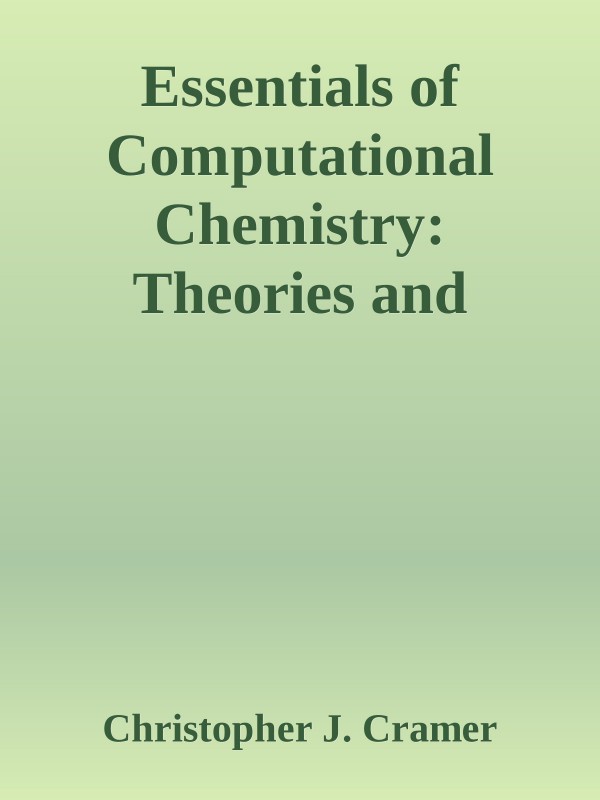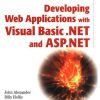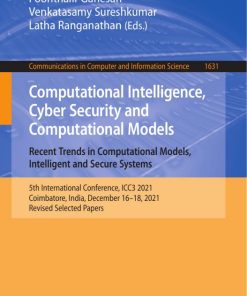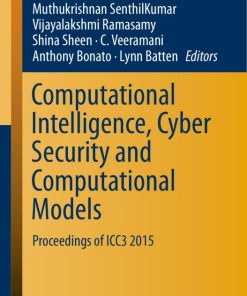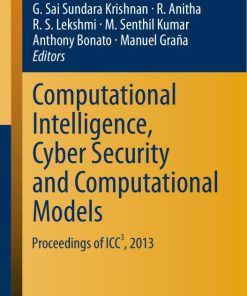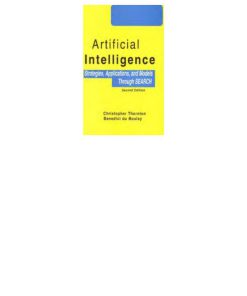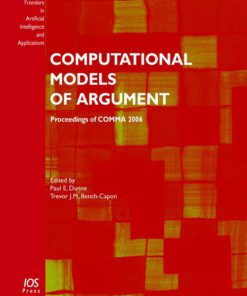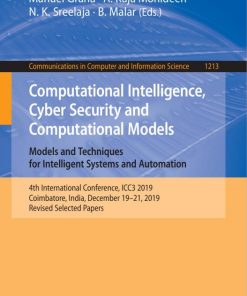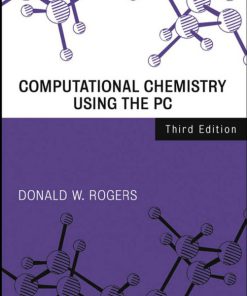Essentials of Computational Chemistry Theories and Models 2nd Edition by Christopher Cramer 0470091819 9780470091814
$50.00 Original price was: $50.00.$25.00Current price is: $25.00.
Authors:Christopher J. Cramer , Series:Chemistry [1] , Tags:Science; Chemistry; Physical & Theoretical; General , Author sort:Cramer, Christopher J. , Ids:Google; 9781118712276 , Languages:Languages:eng , Published:Published:Apr 2013 , Publisher:John Wiley & Sons , Comments:Comments:Essentials of Computational Chemistry provides a balanced introduction to this dynamic subject. Suitable for both experimentalists and theorists, a wide range of samples and applications are included drawn from all key areas. The book carefully leads the reader thorough the necessary equations providing information explanations and reasoning where necessary and firmly placing each equation in context.
Essentials of Computational Chemistry Theories and Models 2nd Edition by Christopher Cramer – Ebook PDF Instant Download/Delivery. 0470091819, 9780470091814
Full download Essentials of Computational Chemistry Theories and Models 2nd Edition after payment
Product details:
ISBN 10: 0470091819
ISBN 13: 9780470091814
Author: Christopher J. Cramer
Essentials of Computational Chemistry provides a balanced introduction to this dynamic subject. Suitable for both experimentalists and theorists, a wide range of samples and applications are included drawn from all key areas. The book carefully leads the reader thorough the necessary equations providing information explanations and reasoning where necessary and firmly placing each equation in context.
Essentials of Computational Chemistry Theories and Models 2nd Table of contents:
1 What are Theory, Computation, and Modeling?
1.1 Definition of Terms
1.2 Quantum Mechanics
1.3 Computable Quantities
1.4 Cost and Efficiency
1.5 Note on Units
Bibliography and Suggested Additional Reading
References
2 Molecular Mechanics
2.1 History and Fundamental Assumptions
2.2 Potential Energy Functional Forms
2.3 Force-field Energies and Thermodynamics
2.4 Geometry Optimization
2.5 Menagerie of Modern Force Fields
2.6 Force Fields and Docking
2.7 Case Study: (2R*4S*)-1-Hydroxy-2,4-dimethylhex-5-ene
Bibliography and Suggested Additional Reading
References
3 Simulations of Molecular Ensembles
3.1 Relationship Between MM Optima and Real Systems
3.2 Phase Space and Trajectories
3.3 Molecular Dynamics
3.4 Monte Carlo
3.5 Ensemble and Dynamical Property Examples
3.6 Key Details in Formalism
3.7 Force Field Performance in Simulations
3.8 Case Study: Silica Sodalite
Bibliography and Suggested Additional Reading
References
4 Foundations of Molecular Orbital Theory
4.1 Quantum Mechanics and the Wave Function
4.2 The Hamiltonian Operator
4.3 Construction of Trial Wave Functions
4.4 Hückel Theory
4.5 Many-electron Wave Functions
Bibliography and Suggested Additional Reading
References
5 Semiempirical Implementations of Molecular Orbital Theory
5.1 Semiempirical Philosophy
5.2 Extended Hückel Theory
5.3 CNDO Formalism
5.4 INDO Formalism
5.5 Basic NDDO Formalism
5.6 General Performance Overview of Basic NDDO Models
5.7 Ongoing Developments in Semiempirical MO Theory
5.8 Case Study: Asymmetric Alkylation of Benzaldehyde
Bibliography and Suggested Additional Reading
References
6 Ab Initio Implementations of Hartree-Fock Molecular Orbital Theory
6.1 Ab Initio Philosophy
6.2 Basis Sets
6.3 Key Technical and Practical Points of Hartree-Fock Theory
6.4 General Performance Overview of Ab Initio HF Theory
6.5 Case Study: Polymerization of 4-Substituted Aromatic Enynes
Bibliography and Suggested Additional Reading
References
7 Including Electron Correlation in Molecular Orbital Theory
7.1 Dynamical vs. Non-dynamical Electron Correlation
7.2 Multiconfiguration Self-Consistent Field Theory
7.3 Configuration Interaction
7.4 Perturbation Theory
7.5 Coupled-cluster Theory
7.6 Practical Issues in Application
7.7 Parameterized Methods
7.8 Case Study: Ethylenedione Radical Anion
Bibliography and Suggested Additional Reading
References
8 Density Functional Theory
8.1 Theoretical Motivation
8.2 Rigorous Foundation
8.3 Kohn–Sham Self-consistent Field Methodology
8.4 Exchange-correlation Functionals
8.5 Advantages and Disadvantages of DFT Compared to MO Theory
8.6 General Performance Overview of DFT
8.7 Case Study: Transition-Metal Catalyzed Carbonylation of Methanol
Bibliography and Suggested Additional Reading
References
9 Charge Distribution and Spectroscopic Properties
9.1 Properties Related to Charge Distribution
9.2 Ionization Potentials and Electron Affinities
9.3 Spectroscopy of Nuclear Motion
9.4 NMR Spectral Properties
9.5 Case Study: Matrix Isolation of Perfluorinated p-Benzyne
Bibliography and Suggested Additional Reading
References
10 Thermodynamic Properties
10.1 Microscopic–macroscopic Connection
10.2 Zero-point Vibrational Energy
10.3 Ensemble Properties and Basic Statistical Mechanics
10.4 Standard-state Heats and Free Energies of Formation and Reaction
10.5 Technical Caveats
10.6 Case Study: Heat of Formation of H2NOH
Bibliography and Suggested Additional Reading
References
11 Implicit Models for Condensed Phases
11.1 Condensed-phase Effects on Structure and Reactivity
11.2 Electrostatic Interactions with a Continuum
11.3 Continuum Models for Non-electrostatic Interactions
11.4 Strengths and Weaknesses of Continuum Solvation Models
11.5 Case Study: Aqueous Reductive Dechlorination of Hexachloroethane
Bibliography and Suggested Additional Reading
References
12 Explicit Models for Condensed Phases
12.1 Motivation
12.2 Computing Free-energy Differences
12.3 Other Thermodynamic Properties
12.4 Solvent Models
12.5 Relative Merits of Explicit and Implicit Solvent Models
12.6 Case Study: Binding of Biotin Analogs to Avidin
Bibliography and Suggested Additional Reading
References
13 Hybrid Quantal/Classical Models
13.1 Motivation
13.2 Boundaries Through Space
13.3 Boundaries Through Bonds
13.4 Empirical Valence Bond Methods
13.5 Case Study: Catalytic Mechanism of Yeast Enolase
Bibliography and Suggested Additional Reading
References
14 Excited Electronic States
14.1 Determinantal/Configurational Representation of Excited States
14.2 Singly Excited States
14.3 General Excited State Methods
14.4 Sum and Projection Methods
14.5 Transition Probabilities
14.6 Solvatochromism
14.7 Case Study: Organic Light Emitting Diode Alq3
Bibliography and Suggested Additional Reading
References
15 Adiabatic Reaction Dynamics
15.1 Reaction Kinetics and Rate Constants
15.2 Reaction Paths and Transition States
15.3 Transition-state Theory
15.4 Condensed-phase Dynamics
15.5 Non-adiabatic Dynamics
15.6 Case Study: Isomerization of Propylene Oxide
Bibliography and Suggested Additional Reading
References
Appendix A Acronym Glossary
Appendix B Symmetry and Group Theory
B.1 Symmetry Elements
B.2 Molecular Point Groups and Irreducible Representations
B.3 Assigning Electronic State Symmetries
B.4 Symmetry in the Evaluation of Integrals and Partition Functions
Appendix C Spin Algebra
C.1 Spin Operators
C.2 Pure- and Mixed-spin Wave Functions
C.3 UHF Wave Functions
C.4 Spin Projection/Annihilation
Reference
Appendix D Orbital Localization
D.1 Orbitals as Empirical Constructs
D.2 Natural Bond Orbital Analysis
People also search for Essentials of Computational Chemistry Theories and Models 2nd:
essential chemistry chapter 9
8 central themes of chemistry
6 essential elements chemistry
computational chemistry basics
You may also like…
eBook PDF
Computational Chemistry Using the PC 3rd Edition by Donald Rogers 0471428000 9780471428008

